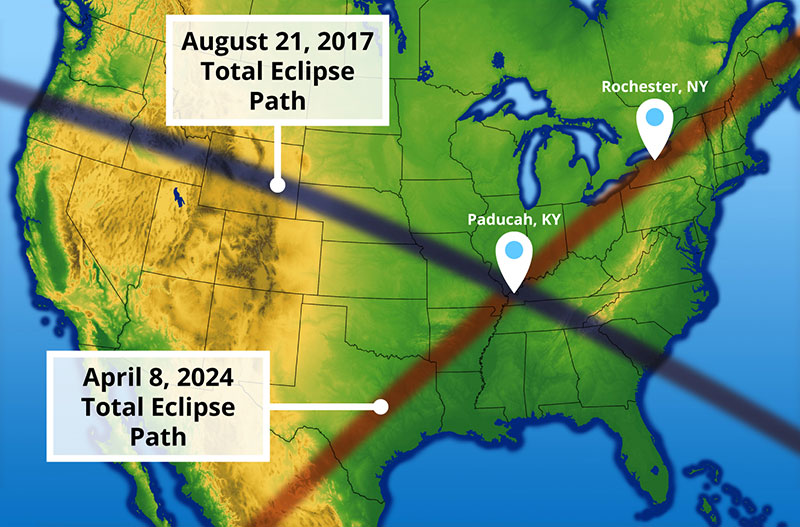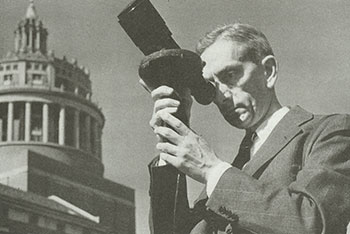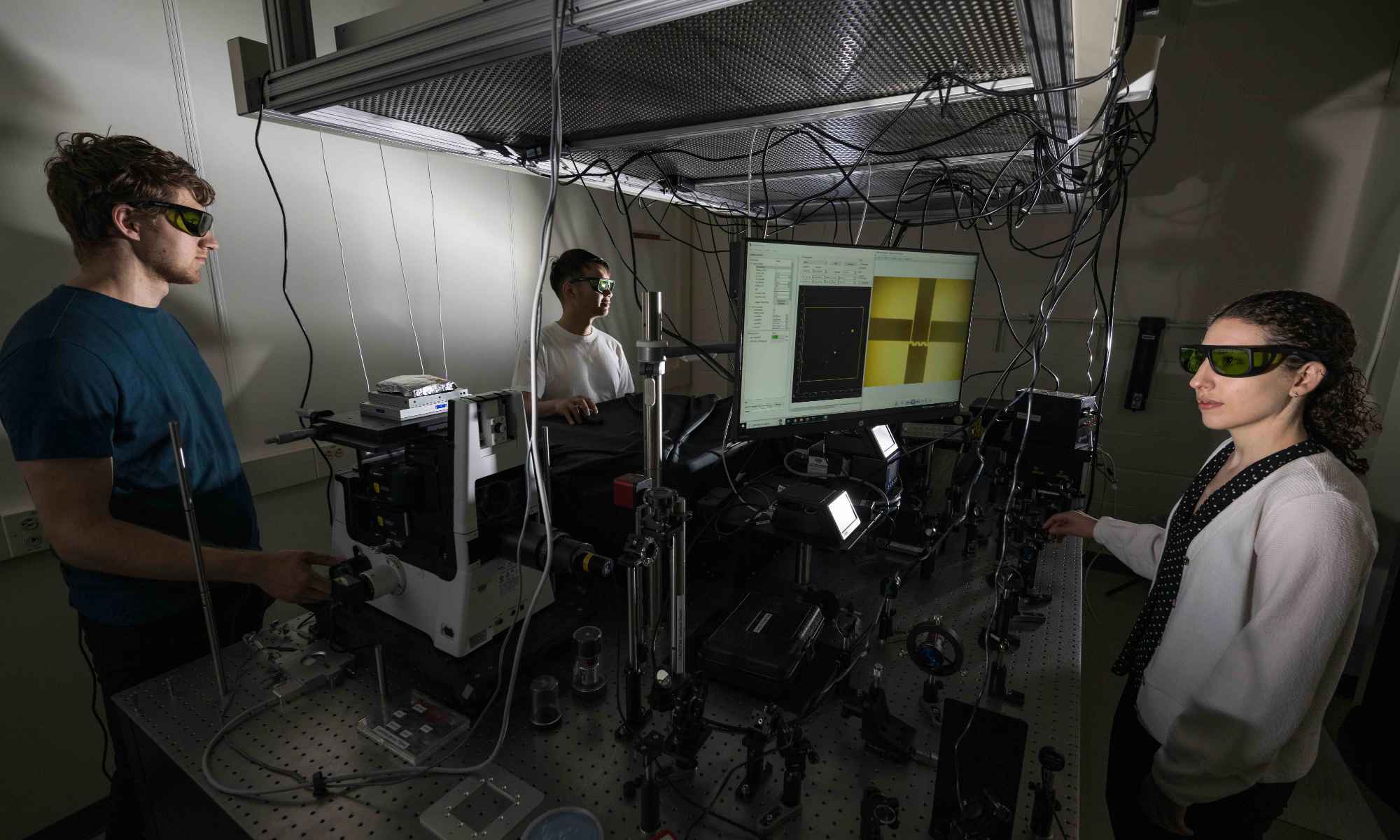On Monday, August 21, 2017, the entire United States will experience a rare summer phenomenon: a solar eclipse in which the moon will block out all or a portion of the sun, depending on where you are standing. This is the first time since 1979 that every state, including Hawaii and Alaska, will witness at least a portion of the eclipse, although the amount of this blockage will vary.
Here in Rochester, we will experience a partial solar eclipse, beginning at 1:14 p.m. and ending at 3:52 p.m. The maximum 70 percent of the sun will be covered by 2:35 p.m.
Although we will only witness a partial solar eclipse this year, mark your calendars for April 8, 2024, when Rochester will experience a total solar eclipse for 3 minutes and 40 seconds at around 3:21 p.m.

The closest place within easy driving distance to Rochester that will witness the total solar eclipse this year is Nashville, Tennessee, which is where Dan Watson, University of Rochester professor and chair of physics and astronomy, will head for the viewing of what he calls “an incredibly impressive event.”
In preparation for the event, Watson answers questions about the eclipse and the best way to view it in Rochester.
Q&A with Dan Watson
What causes an eclipse of the sun?
The shadow of the moon, as the moon passes between you and the sun. The moon’s shadow has two parts: the umbra, which is the central region, and the penumbra, which is the outer region. People in the path of the umbra will see a total solar eclipse whereas those on the area of Earth where the penumbra passes over will see a partial eclipse. Earth is bigger than the moon’s shadow, so where you’re standing on Earth makes a difference.
Dates past and future where the area now known as Rochester, New York, has been (or will be) in a total eclipse path.
- June 25, 745 BC
- March 1, 192 AD
- December 1, 411 AD
- July 21, 567 AD
- May 15, 831 AD
- December 10, 1349 AD
- June 16, 1806 AD
- January 24, 1925 AD
- April 8, 2024 AD
- October 26, 2144 AD
- June 3, 2505 AD
How often do total eclipses of the sun happen?
In any specific place on Earth, about once per 400 years on the average. Paducah, Kentucky is extremely lucky to get two total solar eclipses within seven years—both this year and in 2024. Seeing a total eclipse is very exciting because it’s less frequent than once in a lifetime, unless you travel to see one.
Why don’t total eclipses of the sun happen more often?
They can only happen when the center of the moon lays between the earth and the sun, along the straight line connecting that place on Earth and the center of the sun. Because the moon’s orbit around the earth is tipped slightly from the earth’s orbit around the sun, this arrangement is rare.
How do we know when eclipses will happen?
Astronomers have measured the orbits of the moon and planets, and the position and speed of each in their orbit, extremely accurately. With these data, and computers, we can basically make movies of the motions of Earth and the moon: movies that cover as many years as we want, played in fast-motion. We can play the movies forwards or backwards, and find when the earth, moon and sun line up for an eclipse, in the future or the past.
How excited should I feel about this year’s partial solar eclipse in Rochester?
Moderately excited. Even though this year it will only be a partial eclipse, it probably won’t be clouded out. August is the best time to see an eclipse in Rochester because it is statistically the clearest month. The total eclipse in 2024 is in April, which is historically a cloudy month in Rochester.
What is it like during a partial solar eclipse versus a total eclipse?
During a total eclipse, it becomes like twilight for those two to three minutes of totality. Going from daylight to a period of relative darkness during the middle of the day is incredible to witness. During a partial eclipse, the sun will look like a crescent in the sky and the day will get a little darker, but it won’t be as striking as a total eclipse.
How can I safely watch a total or partial eclipse of the sun?
Only by watching a projected image of the sun or by using special glasses, like those made of aluminum-coated plastic. You should never look at the sun without proper eye protection. Even a brief glance can cause permanent damage to your retinas, although the effects may not be immediate.
Where to view the partial solar eclipse on the River Campus:
Hajim Science and Engineering Quad, 1:00-4:00 pm
- Solar telescope
Meliora Plaza, 1:00-3:30 pm
- Tickets to view the eclipse from the Rush Rhees tower (available to the first 50 University ID holders)
- Eclipse viewing glasses
- Information posters, handout, and binder, information about the University’s AstroClub
Rush Rhees Lam Square, 1:00-3:30 pm
- Live-streaming of NASA coverage, information handout and binder, information about the University’s AstroClub
Carlson Library VISTA Collaboratory, 1:00-3:30 pm
- Live-streaming of NASA coverage, information handout and binder, information about the University’s AstroClub
Physics-Optics-Astronomy Library, 1:00-3:30 pm
- Live-streaming of NASA coverage, information handout and binder, information about the University’s AstroClub
Some additional places in the Rochester community holding eclipse-viewing events:
- Rochester Museum and Science Center
- Many local libraries will be passing out solar glasses. Joe Altieri of the Astronomy Section Rochester Academy of Science (ASRAS) has a number of family-oriented activities scheduled for the day of the eclipse. He will be at Chili, Mendon, and Penfield libraries to talk about the myths surrounding the eclipse as witnessed and experienced by our ancestors, the physics of the eclipse, and safe viewing tips.
Rochester’s Icaroscope

In the 1940s, researchers at the University of Rochester’s Institute of Optics developed a telescope to “safely” look at the sun. During World War II, soldiers used this so-called Icaroscope—named after the mythical Icarus who flew too near the sun—to view enemy planes dive bombing in the pilots’ shadows. In the picture seen here from the 1940s, Brian O’Brien, the first director of the institute, uses an Icaroscope to look at the sun.
During this year’s partial solar eclipse on August 21, Jim Zavislan, an associate professor of optics, and members of the University’s student chapter of SPIE, will have a modern version of this solar telescope set up on the Hajim Science and Engineering Quad for people to view the sun’s atmosphere: “With this telescope, observers can see the solar chromosphere, the layer above the solar photosphere [the visible surface of the sun]. Depending on the solar activity during the eclipse, solar prominences may be visible.”




